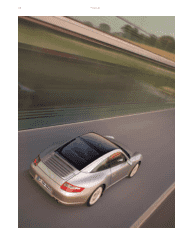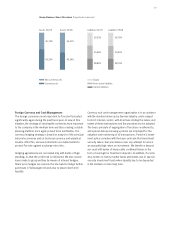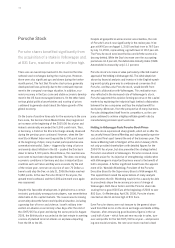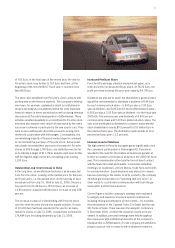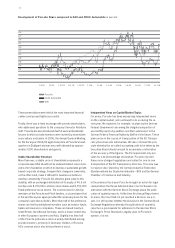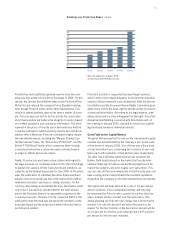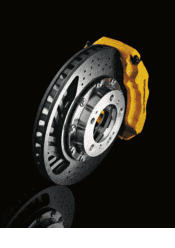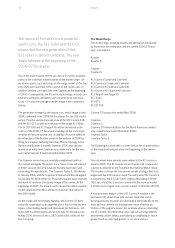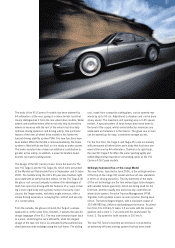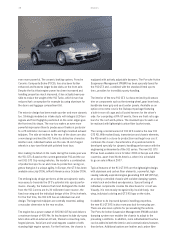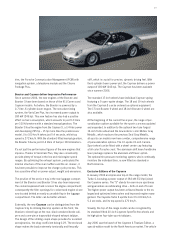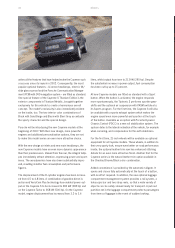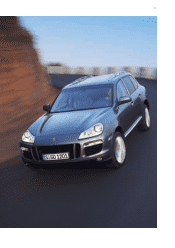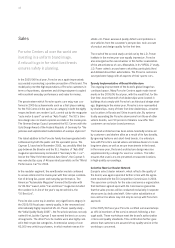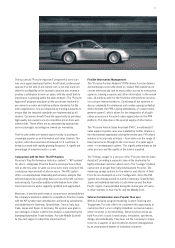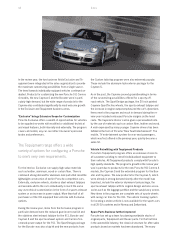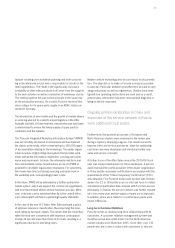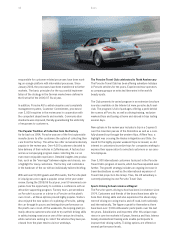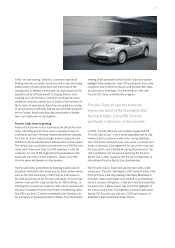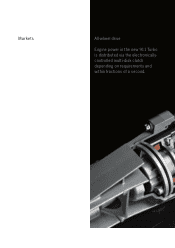Porsche 2005 Annual Report Download - page 40
Download and view the complete annual report
Please find page 40 of the 2005 Porsche annual report below. You can navigate through the pages in the report by either clicking on the pages listed below, or by using the keyword search tool below to find specific information within the annual report.
38
even more powerful. The ceramic braking system, Porsche
Ceramic Composite Brake (PCCB), has also been further
enhanced and features larger brake disks on the front axle.
Despite the fact that engine power has been increased and
handling properties much improved, it has actually been pos-
sible to reduce the weight of the 911Turbo, which in turn has
reduced fuel consumption for example by using aluminum for
the doors and luggage compartment lid.
The exterior design has been made sportier and more dynamic
too. Strikingly modeled air intake ducts with integral LED turn
signals and front foglights positioned on the outer edges give
the front-end its shape. The rear too makes an even more
powerful impression than its predecessor thanks in particular
to a 22 millimeter increase in width and high-mounted exhaust
tailpipes. The side air intakes to the rear of the doors are also
a new design and lend the 911Turbo its distinctive character.
Another neat, individual feature are the new 19-inch forged
wheels in a two-tone finish with polished front face.
Also making its debut on the roads during the review year was
the 911GT3. Based on the current generation 911 and the cur-
rent 911 GT3 Cup racing vehicles, the model is a combination
of production sports car and close-to-production racing car,
genes that give it a unique agility. In Europe, the GT3 has been
available since July 2006, in North America since October 2006.
The striking body design performs all the aerodynamic tasks
necessary to translate the GT3’s potential into sporty perfor-
mance. Visually, the features that most distinguish the model
from the 911 Carrera are its 30 millimeter lower stance, the
fixed rear wing and the individual design of the 19-inch wheels.
For the first time, the 911 GT3 has an individual rear-end
design. The large twin tailpipes are centrally mounted, adding
a muscular dimension to the rear section.
The engine has a power output of 305 kW (415 hp) and delivers
a maximum torque of 405 Nm. Its key features include dry-sump
lubrication with an external oil tank, titanium connecting-rods,
forged pistons, VarioCam and small tappets capable of with-
standing high engine speeds. For the first time, the chassis is
equipped with actively adjustable dampers. The Porsche Active
Suspension Management (PASM) has been specially tuned for
the 911 GT3 and, combined with the standard-fitted sports
tires, provides for incredibly sporty handling.
The interior of the new 911 GT3 is characterized by Alcantara
trim on components such as the steering wheel, gear lever knob,
handbrake lever grip and seat center panels. Available as an
option at no extra cost is the Clubsport package featuring
a bolt-in rear roll cage and a 6-point harness for the driver’s
side. For competing at FIA GT events, there are front roll-cage
bars for the roof and A-pillars. The standard sports seats can
be replaced with lightweight carbon fiber bucket seats.
The racing-oriented variant of 911 GT3 model is the new 911
GT3 RS. With evolved body, transmission and chassis elements,
the RS variant is a close-to-production road-legal race car. It
combines the classic characteristics of a purebred vehicle
developed specially for dynamic handling performance with the
engineering achievements of the 911 series. The new 911 GT3
RS has been available since October 2006 in Europe and other
countries, apart from North America, where it is scheduled
to go on sale in March 2007.
Typical features of the 911 GT3 RS are the lightweight design,
with aluminum and carbon fiber elements, a powerful, high-
revving naturally-aspirated engine generating 305 kW (415 hp),
an actively-controlled chassis with variable damping system,
a wide track and refined aerodynamics. Special tuning of
individual components creates the ideal basis for circuit use.
Visually, it is most easily recognized by its wide body, rear
wing, individual coloring and GT3 RS logo on the sides.
In addition to its improved dynamic handling properties,
the new 911GT3 RS is also more practical for everyday use.
There are also more options for personalizing the vehicle.
The Porsche Active Suspension Management (PASM) variable
damping system now enables the chassis to adapt to the
prevailing conditions. In addition, more individualized touches
can be added to both the interior and communications features
than before. Additional options are leather and carbon fiber
Models


